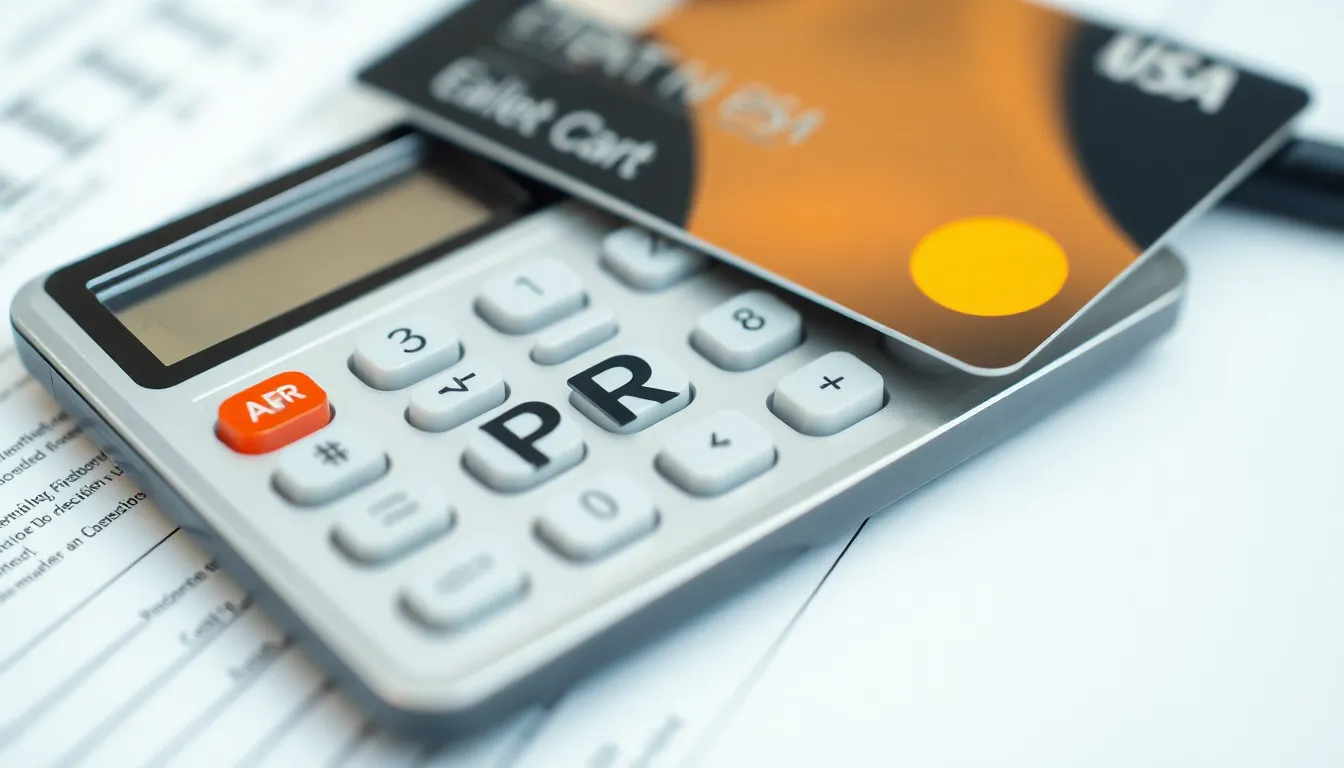Understanding APR is crucial for anyone navigating the world of credit cards. APR, or Annual Percentage Rate, represents the cost of borrowing money over a year. It’s the interest charged on unpaid balances and can significantly impact how much a cardholder ultimately pays for their purchases.
Different credit cards come with varying APRs, which can be fixed or variable. A lower APR can save money in interest charges, making it essential for consumers to compare rates before choosing a card. By grasping the concept of APR, individuals can make informed financial decisions and manage their credit more effectively.
What Is APR for Credit Card?
APR, or Annual Percentage Rate, represents the annual cost of borrowing on a credit card. It includes both interest and fees associated with the borrowed amount. Credit card APRs can vary, generally ranging from 10% to 30%.
Credit cards feature two main types of APR:
- Fixed APR: This rate remains constant for the duration of the balance. While it offers predictability, it can still change if the card issuer makes adjustments.
- Variable APR: This rate fluctuates based on a benchmark interest rate. Such rates can change at any time, impacting monthly payments.
Understanding APR helps consumers gauge total repayment costs. For example, an outstanding balance of $1,000 at a 20% APR incurs $200 in interest over one year if payments aren’t made.
Choosing a credit card with a lower APR encourages cost-effective borrowing. Customers should compare different cards to find those with advantageous rates and favorable terms. Analyzing APR alongside additional fees ensures informed decision-making regarding credit usage.
Understanding APR

APR, or Annual Percentage Rate, represents the annual cost of borrowing money through a credit card, encompassing both interest rates and any associated fees. It plays a crucial role in determining how much a consumer pays over time for their credit use.
Definition of APR
APR provides a comprehensive measure of borrowing costs associated with credit cards. It combines the nominal interest rate with any additional fees. For instance, if a credit card has a nominal interest rate of 18% plus a $50 annual fee, the APR may exceed 18% depending on the cardholder’s average balance. This metric enables consumers to compare credit options effectively.
Importance of APR in Credit Cards
Understanding APR is vital for making informed financial decisions regarding credit cards. A lower APR leads to lower overall interest charges, which benefits consumers who carry balances from month to month. For example, a cardholder with a $1,000 balance at 15% APR incurs $150 in interest annually, while a balance at 25% APR generates $250 in interest within the same period. Lower APRs can significantly reduce long-term costs, emphasizing the need for consumers to evaluate and compare rates before selecting a card. Recognizing the impact of both fixed and variable APRs further aids in expenses management.
Types of APR
Credit cards display various types of APR, impacting how interest accumulates based on card usage. Understanding these different APR types aids in managing costs effectively.
Purchase APR
Purchase APR applies to regular purchases made using a credit card. This rate determines the interest charged on outstanding balances from new purchases if not paid in full by the due date. Typically, this APR is identified as either fixed or variable. Fixed purchase APR remains consistent, while variable rates may change based on benchmark rates, such as the prime rate. For example, if a cardholder has a balance of $1,000 with a purchase APR of 18%, interest incurs at $180 annually if left unpaid.
Balance Transfer APR
Balance transfer APR applies when transferring debt from one credit card to another. This rate can vary; often, promotional offers feature lower introductory rates for a specific period. After the promotional period, the rate may revert to the standard APR. It’s crucial to consider any transfer fees that might apply when calculating the overall cost. For instance, if transferring a $500 balance incurs a 3% fee and the balance transfer APR is set at 12%, the total balance payable becomes $515, plus interest thereafter.
Cash Advance APR
Cash advance APR incurs when withdrawing cash using a credit card. This rate generally exceeds the purchase APR and often starts accruing interest immediately, without a grace period. Cash advances also typically involve transaction fees, adding to the total cost. For example, if the cash advance APR is 25% and a cardholder withdraws $200, they incur $50 in interest over one year, along with any applicable cash advance fees. Understanding this APR type is essential for avoiding unexpected charges.
How APR Affects Credit Card Users
Understanding how APR affects credit card users is crucial for managing costs and making informed decisions. APR influences both interest accumulation and monthly payments, impacting overall financial well-being.
Interest Accumulation
APR dictates the rate at which interest accumulates on outstanding credit card balances. When users carry a balance, interest accrues daily based on the card’s APR. This means a higher APR results in faster interest growth, increasing the total repayment amount. For example, a $1,000 balance with a 20% APR can accumulate approximately $200 in interest over a year if not paid off. Conversely, a balance at a 15% APR accumulates about $150 in the same timeframe. Understanding this relationship allows users to see the significant effect of APR on the total cost of borrowing, emphasizing the importance of timely payments to minimize interest charges.
Impact on Monthly Payments
APR directly affects monthly payments for credit card users. A higher APR leads to larger minimum payments since accrued interest adds to the total balance. For instance, a cardholder with a $1,000 balance at a 20% APR may face monthly payments near $100, while the same balance at a 15% APR could result in payments around $80. These numbers can vary based on the card issuer’s policies, but the principle remains clear: lower APRs lead to reduced financial pressure. By selecting cards with favorable APRs, users can optimize their monthly budgets and effectively manage their financial obligations.
Tips for Managing APR
Managing APR effectively can lead to significant savings and improved financial health. Adopting informed strategies helps consumers minimize interest charges and maintain control over their credit card usage.
Comparing Offers
Comparing credit card offers is crucial for finding the best APR. He or she should assess various cards, looking for lower APRs, as these reduce overall borrowing costs. Consumers can use online comparison tools to evaluate multiple offers simultaneously, focusing on factors like promotional APR periods and associated fees. Identifying fixed versus variable APRs also plays a key role; fixed APRs provide stability, while variable rates may change based on market conditions. Keeping track of promotional rates helps ensure users take advantage before they revert to higher standard rates.
Paying on Time
Paying credit card bills on time is vital for managing APR effectively. Timely payments minimize interest accumulation and avoid late fees, which can increase the overall APR charged. Setting up reminders or automated payments can help ensure that payments arrive on or before the due date. Maintaining a consistent payment schedule also positively impacts credit scores, which can lead to better APR offers in the future. If unexpected circumstances arise, communicating with the credit card issuer can sometimes yield temporary relief or hardship options that prevent rates from escalating.
Understanding APR is crucial for anyone using credit cards. It not only affects how much interest accumulates on outstanding balances but also influences monthly payments. By choosing cards with lower APRs and being aware of different types of APR, consumers can make informed decisions that lead to savings and better financial management.
Timely payments and careful comparison of credit card offers can further enhance financial health. Staying proactive in managing APR can significantly reduce overall costs and improve one’s credit profile. Ultimately, a solid grasp of APR empowers consumers to navigate their credit options effectively and avoid unexpected charges.













